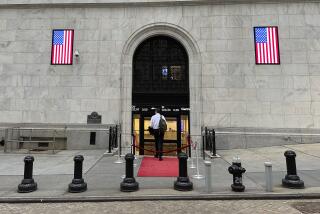International Business : U.S. Offers Concession in Bid to Renew Japan Chip Accord
- Share via
Anxious to avert an election-year trade battle, the United States has agreed to relinquish a powerful trade lever--numerical targets--in hopes of winning renewal of a controversial agreement designed to expand foreign access to the Japanese semiconductor market.
But Japanese government and industry leaders have spurned the olive branch and, in a two-day meeting with their U.S. counterparts that begins today in Newport Beach, are expected to repeat their assertion that the U.S.-Japan semiconductor agreement has outlived its usefulness and should be allowed to expire at the end of July.
They point to the expansion of foreign market share in Japan since the agreement’s inception--the U.S. share alone jumped from 8.5% in 1986 to 17% in 1994--as proof that foreign semiconductor makers no longer need help selling to Japanese electronics firms, auto companies and telecommunications giants.
“The Japanese have absolutely said no renewal, under no circumstances,” said a U.S. official in Tokyo, who spoke on condition of anonymity. “The Japanese see this as the agreement that started the whole business of targets, affirmative action in trade, so they’d like to kill it.”
U.S. officials fear Japan’s refusal to even discuss an extension of the five-year agreement has set the stage for a confrontation that could damage U.S.-Japanese relations on the eve of President Clinton’s April visit to Tokyo and hurt the U.S. semiconductor industry’s expansion in the Japanese market.
Charles White, a Motorola vice president and head of the U.S. Semiconductor Industry Assn.’s Japan group, said his group’s decision to drop its insistence that the agreement include numerical targets is a “pragmatic” one intended to head off a protracted legal battle before the World Trade Organization, the newly formed global trade group based in Geneva.
“We’d hate to get caught up in some larger battle of wills between the two governments, which is really more political in nature than pragmatic,” said the Motorola executive, who will represent the U.S. industry in today’s meetings.
But White and others said the U.S. decision to drop the numerical target does not represent any weakening of their resolve to see the agreement renewed for an unspecified period.
“My belief is that whatever burdensome conditions exist in the present arrangement could be dealt with in the spirit of compromise and cooperation in some new agreement,” White said. “But I frankly think it’s too early to bail on this one.”
The United States wants a renewed agreement that would commit both sides to “gradual and steady” progress for foreign companies, continued U.S.-Japanese industry collaboration and close monitoring of the market.
For months the United States and Japan have staked out their diametrically opposed viewpoints on the future of the semiconductor agreement in high-level meetings, including November’s talks in Osaka between Vice President Al Gore and then-Prime Minister Tomiichi Murayama.
At the meetings in Newport Beach, intended to update progress on the agreement but not conduct negotiations, U.S. trade negotiator Don Phillips is expected to formally request renewal of the agreement in a meeting with his counterpart from Japan’s trade ministry.
The U.S.-Japanese semiconductor agreement has become a symbol of the increasingly contentious battle between what Japan describes as managed trade and the United States considers trade accountability.
Before 1986, U.S. companies argued they were virtually frozen out of the Japanese market because of long-standing relationships between powerful Japanese companies and their suppliers that were supported by Japan’s bureaucracy.
In 1986, Japan agreed to a plan to expand the foreign share of its semiconductor market by encouraging cross-border industry collaboration and establishing a government monitoring program in the United States and Japan.
The agreement, which was renewed in 1991, also developed mechanisms to prevent the Japanese from dumping chips overseas and set a minimum goal of a 20% foreign share of the Japanese market. After dramatic growth last year, the foreign share of the Japanese market now stands at 26.2%.
Since its inception, the Japanese have denounced the semiconductor agreement as an example of U.S.-imposed government intervention in the marketplace. They also fear the agreement’s use as a model for other bilateral trade negotiations, such as last year’s bitter battle to open up the Japanese market to U.S. auto makers.
The Clinton administration has touted the agreement as one of its most successful trade agreements because it established clear goals and set mutually agreed-upon standards for measuring progress.
Both sides apparently agree that a numerical target is no longer necessary, at least in this case. Alan Wolff, chief counsel to the U.S. Semiconductor Industry Assn., said the complexities of the world computer chip industry make it difficult to set a specific target that isn’t “somewhat artificial.” U.S. manufacturers also worry that such a target could backfire and be used as a limit on foreign expansion.
Spurred by their success in Japan and the dramatic expansion of the world appetite for semiconductors, U.S. chip makers have become much more international. Motorola, whose share of the Japanese market has increased fourfold since the agreement’s inception, is teaming up with Toshiba, Siemens and IBM to produce a future version of the dynamic random access memory chips known as DRAMs. Texas Instruments has struck up a partnership with Hitachi to build a semiconductor plant near Dallas.
But even with these foreign tie-ups, U.S. officials said their battle for market access in Japan remains a tough one, particularly in industries such as auto manufacturing, telecommunications and video games, where the purchases of U.S. semiconductors still rank far below those elsewhere in the world.
Times staff writer David Holley in Tokyo contributed to this report.






